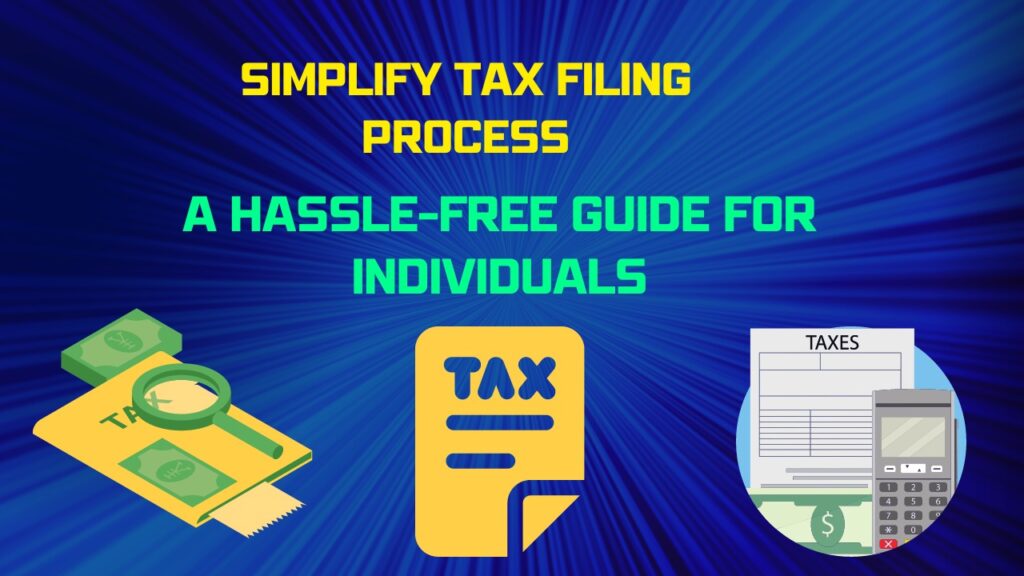Simplify Tax Filing Process: A Hassle-Free Guide for Individuals
Dealing with taxes can be a daunting task for many individuals. The complexity of tax regulations and the fear of making mistakes often lead to stress and confusion. However, by simplifying the tax filing process, you can make it more manageable and less overwhelming. In this article, we will provide you with a step-by-step guide to simplify the tax filing process, ensuring that you can navigate through it smoothly and with confidence.
Tax season can be a stressful time for individuals, but by simplifying the tax filing process, you can reduce the burden and make it more manageable. In this article, we will guide you through each step to ensure a hassle-free experience.
- Understanding Tax Filing
1.1 What is Tax Filing?
Tax filing refers to the process of submitting your income, deductions, and credits to the relevant tax authorities, such as the Internal Revenue Service (IRS) in the United States. It is an annual obligation that allows the government to calculate your tax liability or determine any refund owed to you.
1.2 Why is Tax Filing Important?
Tax filing is essential for several reasons. It ensures compliance with the law, helps you take advantage of available deductions and credits, and enables the government to assess your tax liability accurately. Filing your taxes on time also prevents penalties and interest charges.
- Gathering Necessary Documents
Before you begin the tax filing process, gather all the necessary documents. These include personal information, income documents, and deduction and credit documents.
2.1 Personal Information
Collect essential personal information, such as your Social Security number, date of birth, and address. You will need these details to accurately identify yourself on the tax return.
2.2 Income Documents
Gather all income-related documents, such as W-2 forms from employers, 1099 forms for freelance income, and interest statements from banks. These documents provide crucial information about your earnings during the tax year.
2.3 Deduction and Credit Documents
Compile documents related to deductions and credits, such as receipts for deductible expenses, mortgage interest statements, and proof of educational expenses. These documents will help you claim any deductions or credits you are eligible for.
- Choosing the Right Tax Form
To simplify the tax filing process, choose the appropriate tax form that matches your financial situation. The most common tax forms for individuals are the 1040, 1040A, and 1040EZ forms.
3.1 1040 Form
The 1040 form is the standard tax form used for reporting income, deductions, and credits. It is suitable for individuals with more complex financial situations, such as those with self-employment income or itemized deductions.
3.2 1040A Form
The 1040A form is a simplified version of the 1040 form and is suitable for individuals with less complex financial situations. It allows for certain deductions and credits but does not accommodate itemized deductions.
3.3 1040EZ Form
The 1040EZ form is the simplest tax form and is designed for individuals with straightforward financial situations. It has limited deductions and credits available and is typically used by individuals with no dependents.
- Organizing Your Financial Information
Organizing your financial information is crucial to simplify the tax filing process. Follow these steps to ensure a well-structured approach:
4.1 Separate Personal and Business Expenses
If you have a small business or freelance income, separate your personal and business expenses. Maintain separate bank accounts and credit cards to streamline the tracking of income and expenses.
4.2 Keep Track of Income and Expenses
Maintain accurate records of all your income and expenses throughout the year. Use accounting software or spreadsheets to track these transactions and ensure they are properly categorized.
4.3 Maintain Proper Documentation
Keep all relevant receipts, invoices, and financial statements organized in a systematic manner. This documentation will serve as evidence for any deductions or credits you claim.
- Utilizing Online Tax Filing Services
Online tax filing services can significantly simplify the tax filing process. Consider the following when utilizing these services:
5.1 Benefits of Online Tax Filing
Online tax filing offers several advantages, such as convenience, accuracy checks, and faster refunds. It eliminates the need for paper forms and allows you to complete your taxes from the comfort of your own home.
5.2 Popular Online Tax Filing Platforms
Explore popular online tax filing platforms like TurboTax, H&R Block, and TaxAct. These platforms offer user-friendly interfaces and guidance throughout the filing process.
5.3 Steps to File Taxes Online
When filing taxes online, follow the step-by-step instructions provided by the chosen platform. Enter the required information accurately and review your return before submitting it.
Conclusion
By simplifying the tax filing process, you can alleviate stress and navigate through it with ease. Follow the step-by-step guide outlined in this article, gather the necessary documents, choose the right tax form, and consider utilizing online services or seeking professional help when needed. Maximize deductions and credits, review your return for accuracy, and file your taxes electronically or via mail. Finally, establish a system for future tax seasons and stay informed about any tax law changes. With these strategies in place, tax filing can become a hassle-free process.


